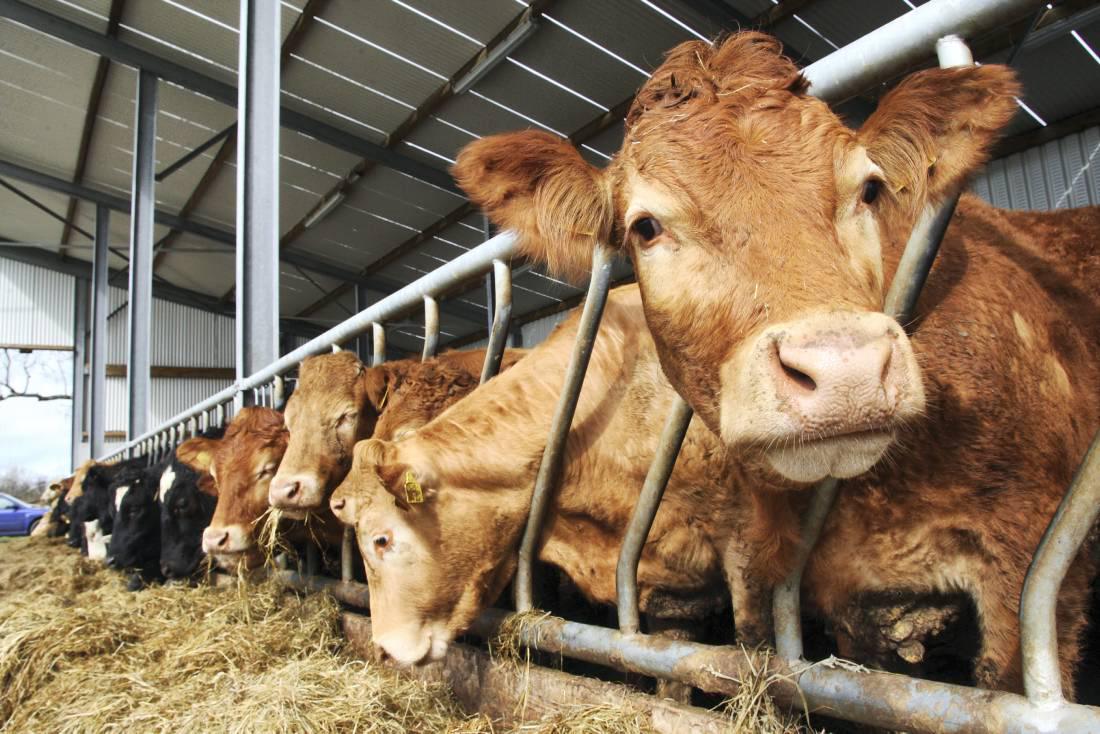The face of our beef industry has changed considerably in recent times, with a greater input from the dairy herd.
Physiological factors such as genetic make-up, sex and age will influence the growth potential and feed conversion efficiency (FCE) of an animal. However,
it is often the environmental factors such as nutrition, housing and health that have the greatest impact on performance and profitability.
Nutrition
Voluntary feed intake greatly influences the performance of the beef animal; meaning that the addition of concentrate to the diet is often vital in
achieving the target daily liveweight gain (DLWG).
Growing Period
The aim of the growing period is to achieve high feed conversion rates and to maximise muscle and frame development. The growing phase is typically
from 150kg to 500+kg, or 450+kg for steers and heifers respectively; with a target DLWG of 0.8kg. However this will vary, depending on the system
and animal type.
Cattle are most efficient at converting feed to live weight gain at a younger age. This should be utilised by providing the youngest animals with a
high quality feed and the best forage available on farm. Forage should not just be viewed as a means of ‘bulking up’ a ration, but as a key component
in helping to meet the nutritional requirements of the animal.
Grass silage will often be the main forage source in grower diets. Aim to make quality fodder, as low dry matter and D-value silages, result in reduced
daily live-weight gain (DLWG); ultimately increasing days to finish.
The data below from a Teagasc trial further highlights this, indicating an average loss of 0.173kg DLWG, where silage D-value was reduced by 4%.
Table 1. Effect of Silage Quality on DLWG and Intakes in Growing Cattle
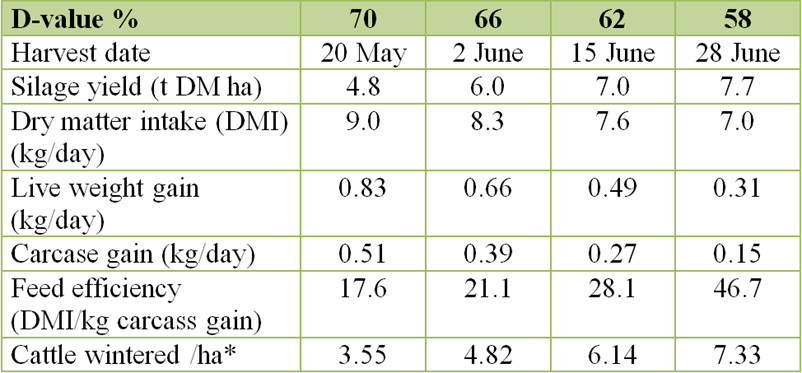
(Teagasc, 2016)
Feeding silage that has a dry matter (DM) of 35% or greater, increases the risk of a mycotoxin challenge. In such cases, toxin binders such as Ultrasorb
R, offered by Chestnutts, may be worth considering. For more information on how to manage high DM silages,
check out our silage report.
Typical grower rations will have a crude protein content of 16-18% and should contain soyabean meal as one of the main sources of protein; to optimise
muscle and frame development.
As heifers deposit fat easier than steers and bulls, it is particularly important that they are fed sufficient protein to develop frame size prior
to moving on to a finishing ration. Whereas, bulls or slower finishing breeds may require lower protein and higher levels of starch in the diet
from an earlier period in order to ensure they meet target market specifications.
At Chestnutts we recognise that one growing blueprint will not suit all farms, and therefore we offer a range of grower rations with various levels
of protein and starch. Our range of feeds are formulated to do the job, with high quality raw materials and optimum levels of vitamins and minerals.
Our in-house advisory team will be able to provide you with advice on which rations are best suited to your system.
Finishing Period
Finishing is a period of short, sharp, weight gain to meet market specifications; where optimum fleshing should subsequently lead to an overall higher
carcase weight, grade and kill out percentage (KO%). With a duration of around 60-120 days, a finishing animal should be capable of achieving a
daily live weight gain of 1.1-1.5kg.
An animal’s requirement for protein is reduced to roughly 11-13% of the total ration, as its frame should be sufficiently developed.
The high energy content will be comprised mainly of cereals (maize, wheat and barley); with the increased starch levels promoting faster weight gains
and a more efficient FCR, especially in larger framed, slower finishing breeds of cattle. Excessively high starch diets (>25%) should be avoided
when finishing native breeds or heifers, which lay down fat easily.
Providing a ration with enough fibre is essential when feeding an intensive finisher ration. Digestible fibres such as soya hulls and sugar beet pulp
can be useful; however it is functional fibres such as silage, hay or straw which are most important to build the fibre mat and encourage rumination.
As the concentrate to forage ratio is increased from that of the grower ration, forage dry matter intakes will subsequently be reduced; increasing
the risk of acidosis developing.
Acidosis is a metabolic disease brought about when rumen pH drops. Subacute ruminal acidosis (SARA) often goes unnoticed in many herds.
Figure 1. Bubbles and lose dung can be a good indication of SARA.
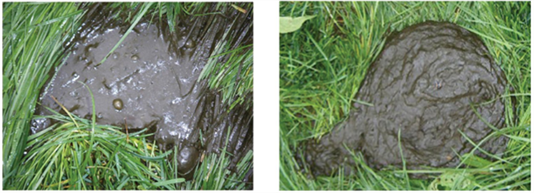
(Agriland, 2018)
In order to reduce the risk of acidosis a gradual increase of concentrate feed in the diet is essential to allow rumen adaption, and special attention
should be paid to purchased cattle.
All our rations contain Actisaf, a live yeast, which stabilises rumen pH by creating an environment for fibre digesting bacteria to thrive.
The addition of AcidBuf into the diet can also be used to help prevent acidosis. Manufactured from calcareous marine algae, this buffer stabilises the rumen environment, by neutralising the acids produced from a high starch diet.
A trial carried out by Harper Adams reported an 8% increase in DLWG where AcidBuf was included, as displayed in figure 2.
Figure 2. The Effect of Acid Buf on the Performance of Cereal Fed Beef Cattle
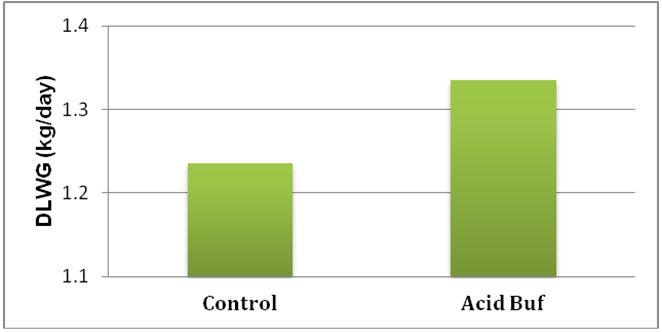
(Harper Adams University College, 2004)
Feed Management & Housing
All too often feed presentation is overlooked, resulting in unnecessary wastage and diminished intakes. Ensuring the ration is fresh, palatable
and constantly available can make a significant difference.
As proven in many research trials, animal comfort and performance are closely linked; with flooring, space, water and airflow all contributing
to an ideal environment.
Adequate space is essential to minimise stress and enhance feed intakes. Ideally, each animal should be have 2-3m2 of floor space and
a minimum of 30cm feed space.
Water intakes will vary, depending on the proportion of dry feed in the diet; with animals on an intensive finisher diet requiring 40+ litres daily.
Where water availability is not adequate, particularly for finishing cattle, the threat of acidosis developing is considerably heightened.
Ideally a fresh breeze, but not a draft, should be felt in all areas of the shed. An inlet is important to draw fresh air into a shed and an outlet
system should remove stale air, allowing adequate air movement and ventilation.
Health
The health status of an animal has a huge impact on economic and physical performance; affecting intakes and the ability of the rumen to effectively
convert nutrients into live weight gain. Though each farm will have its own unique challenges, special attention should be paid to;
- Pneumonia
- Worms/Fluke
- Sub Acute Ruminal Acidosis (SARA)
For information on how to manage your animal’s health, consult your local vet.
A Feed to Suit You
At Chestnutt Animal Feeds we offer a range of compounds and blends, catering for all stages of beef production.
As well as our pre-formulated beef feeds, we also offer bespoke blends, tailored for your individual needs and targets by our nutritionist team.
Focus Farm
Glebe Farm is one such enterprise benefiting from their own Chestnutts blend. Operating a beef finishing enterprise on the shores of Co. Donegal,
the Norris family finish approximately 400 cattle a year; with Charolais bred bulls most prominent within the herd.
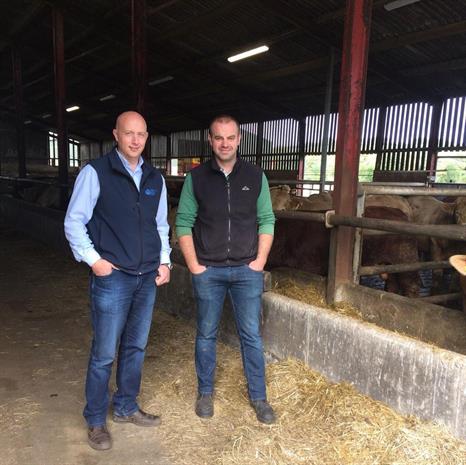
The Norris family chose to have their own blend tailor made by Chestnutts, incorporating both AcidBuf and UltrasorbR; helping to achieve
high carcase weights and kill out percentages at 23 months, and to manage the unique challenges associated with intensive finisher systems.
Since introducing UltrasorbR to the blend, the Norris’ have noted a significant reduction in cattle lameness, especially during
the housed period, over the past number of years.
If having your own bespoke blend is of interest to you, or for further information regarding the range of beef feeds offered by Chestnutts, please
feel free to contact our office on 028 2074 1354, or your local advisor.

